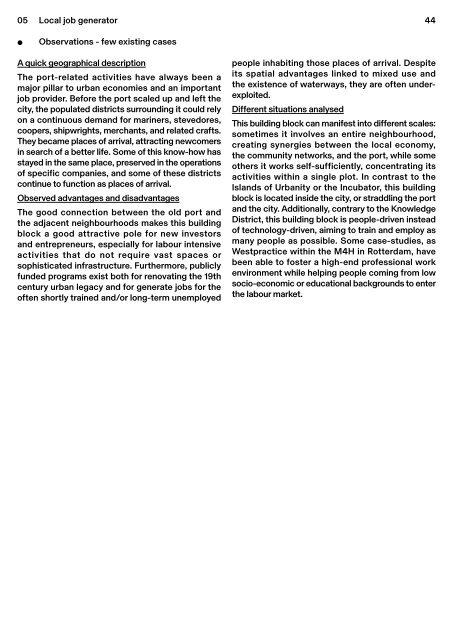Circular (City) Ports_Workbook 2_ Buildings Blocks
Create successful ePaper yourself
Turn your PDF publications into a flip-book with our unique Google optimized e-Paper software.
05 Local job generator<br />
44<br />
●<br />
Observations - few existing cases<br />
A quick geographical description<br />
The port-related activities have always been a<br />
major pillar to urban economies and an important<br />
job provider. Before the port scaled up and left the<br />
city, the populated districts surrounding it could rely<br />
on a continuous demand for mariners, stevedores,<br />
coopers, shipwrights, merchants, and related crafts.<br />
They became places of arrival, attracting newcomers<br />
in search of a better life. Some of this know-how has<br />
stayed in the same place, preserved in the operations<br />
of specific companies, and some of these districts<br />
continue to function as places of arrival.<br />
Observed advantages and disadvantages<br />
The good connection between the old port and<br />
the adjacent neighbourhoods makes this building<br />
block a good attractive pole for new investors<br />
and entrepreneurs, especially for labour intensive<br />
activities that do not require vast spaces or<br />
sophisticated infrastructure. Furthermore, publicly<br />
funded programs exist both for renovating the 19th<br />
century urban legacy and for generate jobs for the<br />
often shortly trained and/or long-term unemployed<br />
people inhabiting those places of arrival. Despite<br />
its spatial advantages linked to mixed use and<br />
the existence of waterways, they are often underexploited.<br />
Different situations analysed<br />
This building block can manifest into different scales:<br />
sometimes it involves an entire neighbourhood,<br />
creating synergies between the local economy,<br />
the community networks, and the port, while some<br />
others it works self-sufficiently, concentrating its<br />
activities within a single plot. In contrast to the<br />
Islands of Urbanity or the Incubator, this building<br />
block is located inside the city, or straddling the port<br />
and the city. Additionally, contrary to the Knowledge<br />
District, this building block is people-driven instead<br />
of technology-driven, aiming to train and employ as<br />
many people as possible. Some case-studies, as<br />
Westpractice within the M4H in Rotterdam, have<br />
been able to foster a high-end professional work<br />
environment while helping people coming from low<br />
socio-economic or educational backgrounds to enter<br />
the labour market.


















